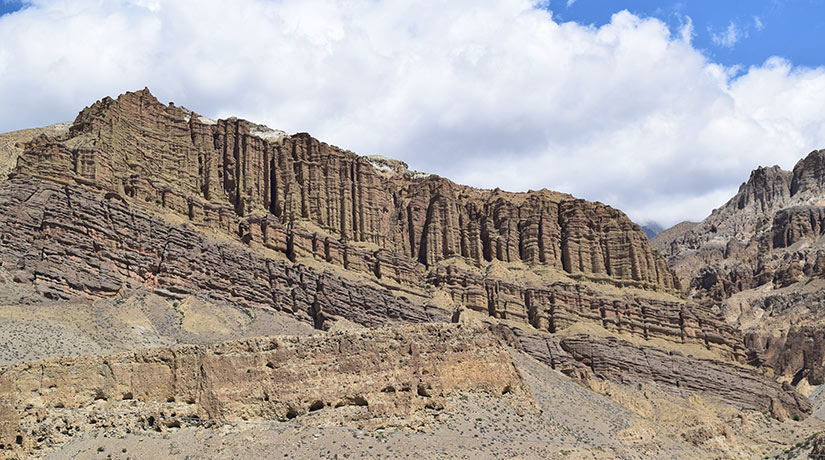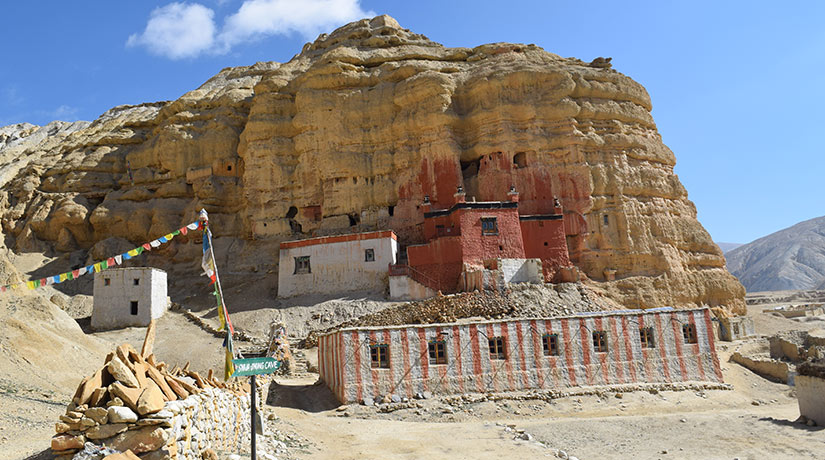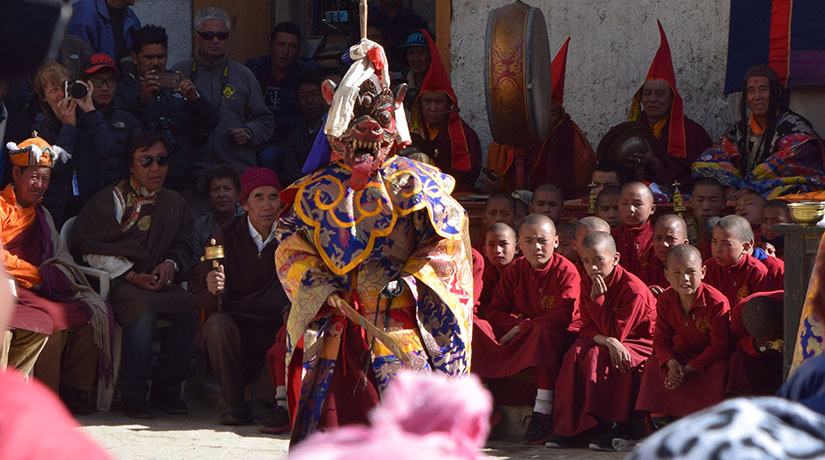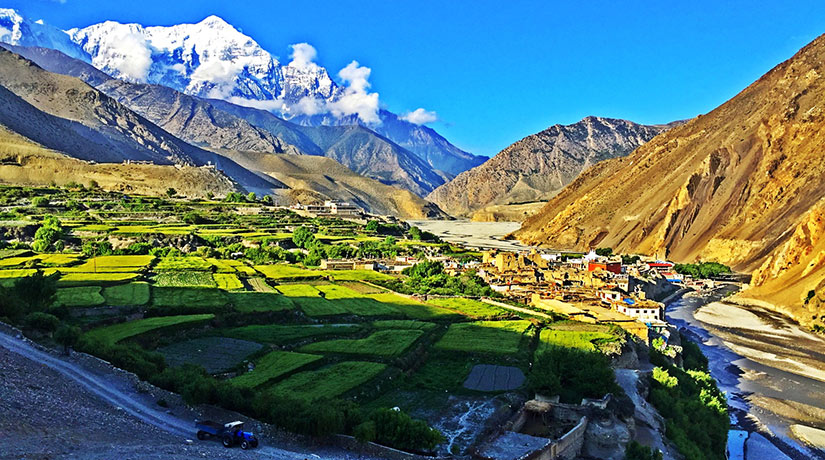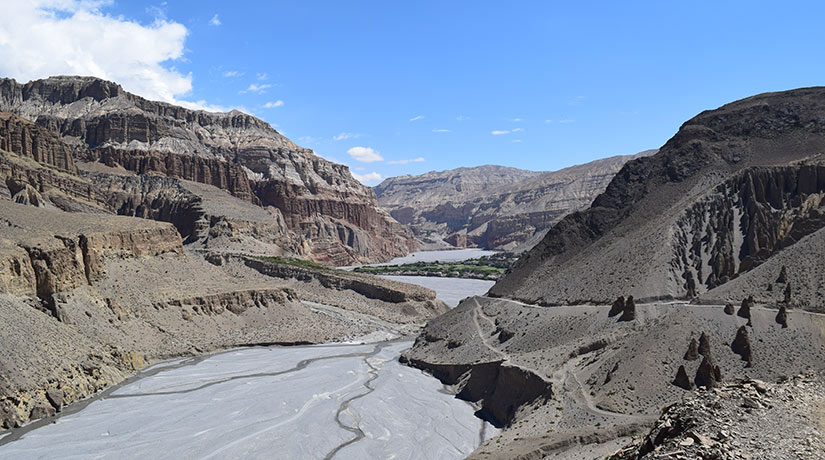Trip Facts
General trp informations2+
Moderate to fairly hard
Teahouse
4100m
B, L, D
Jeep
May - June
The Tiji was/is one of the most important religious and cultural festival in the Upper Mustang region of Nepal. Ancient mythology relates how the Tiji Festival was celebrated to mark the victory of good over evil. It is believed that what is now the Mustang region was in trouble, and was being destroyed by a demon who spread disease and took away water. Dorje Shönnufought and defeated this demon and the festival celebrates his victory with prayer chants and colorful dances.
Dorje Shönnu;Vajrakumara (Skt. Vajrakumāra; Tib.རྡོ་རྗེ་གཞོན་ནུ་,Wyl. rdo rje gzhon nu)known also as Dorje Phurba, Vajrakila, or Vajrakumar) is the name of a deity in Vajrayana Buddhism, an age-old Buddhist practice in India and Nepal. The Buddhist masters Padmasambhava, Vimalamitra and Shilamanju (of Nepal) went on to introduce this practice to Tibet during the 8th century CE, where it then branched into many lineages.
Padamasambhava instructed the major steps in the sacred dance of Vajrakila at Samye Monastery in Tibet. Chhöde Monastery at Lo Manthang in Upper Mustang is famous for its performance of Vajrakila practice and ritual.
However, the Tiji Festival in Upper Mustang did not start until the end of 17th century, when the Mustangi King Samdup Rabten invited Sakya Trizin (Sakya Thorn holder) Ngawang Kunga Sonam to come to Lo Manthang. He stayed at Lo Manthang’s Chhöde Monastery and performed the special Vajrakila ritual for the wellbeing of all sentient beings, and also to dispel all negative elements in Mustang.
Since then, the monks of Chhöde Monastery have been performing this religious dance every year in Lo-Manthang, over three days in the courtyard of Mustang Royal Palace. Originally it was performed at the end of the twelfth month of the Tibetan calendar, but nowadays it is performed during third Tibetan month (May).
The main dancer (Tsowo) head is selected rotationally from the monastery. Actually it’s an intensive ritual practice. The head dancer completes a three-month retreat before the main event. Members of the Mustang royal family and all the villagers of the seven provinces of Upper Mustang (Lo Chhödun) participate in this sacred dance, which is accompanied by many rituals. In the Mustangi (Lobo) dialect it is pronounced as Tiji (or Tenchi or Ten-pa-chyi-rim-dho meaning A ritual worship for the wellbeing of the kingdom) and is a part of the meditation practice based on the Tantra text related to Vajra Kumara (Vajra Kila).
There are two kinds of activities in the build-up to the meditation: first, peaceful dance steps, followed by the subjugation of negative elements, depicted in the Mele or second stage of the dance. There are three major stages of the dance ritual. In the preliminary part of the dance, there are 15 steps. Then in the main part, the ‘generation of the celestial palace’ and ‘generation of deities’ are depicted with two steps. In conclusion, there are steps to clear away eternal and nihilistic views and to provide auspiciousness. Different poses and gestures signify different processes of meditation in symbolic ways, and all of the dance steps have deeper meanings. The obstacles in life are believed to be cleared away by seeing these steps with faith and respect.
Upper Mustang is a remote area by the Tibetan border. Once an independent kingdom, Mustang is closely tied to Tibet in terms of language and culture. From the 15th to the 17th centuries, its strategic location granted Mustang control over the trade between the Himalayas and India. At the end of the 18th century, the kingdom was annexed by Nepal and became a dependency of the Kingdom of Nepal. In 2008, however, the monarchy ceased to exist by order of the Government of Nepal. The last king Jigme Dorje Palbar Bista died in 2016. His ancestor, the warrior Ame Pal, founded the Buddhist kingdom in 1380 and built much of Lo Manthang.
As Tiji is a lunar festival, every year the dates are different.
Outline Itinerary
Day 01: Kathmandu (4265 ft / 1300 m)
Day 02: Kathmandu – Pokhara (2900 ft /884 m)
Day 03: Pokhara to Jomsom (9000 ft / 2700m)
Day 04: Kagbeni to Chaile (10,667 ft / 3200m),
Day 05: Chaile to Syangbochen (10,500 ft / 3150m),
Day 06: Syanbochen to Gemi (12,167 ft / 3650m),
Day 07: Gemi to Tsarang (12,167 ft / 3650m)
Day 08: Tsarang to Lo Manthang (12,533 ft / 3760m).
Day 09: In Lo Manthang (12,533 ft / 3760m).
Day 10: In Lo Manthang (12,533 ft / 3760m).
Day 11: Lomanthang to Dhakmar (12,733 ft / 3820m),
Day 12: Dhakmar to Samar (12,200 ft / 3660m).
Day 13: Samar to Kagbeni (9,367 ft / 2810m).
Day 14: Muktinath (3760m) to Jomsom (9000 ft / 2700m)
Day 15: Jomsom to Pokhara flight, then Pokhara to Kathmandu
Day 16: Depart Nepal
What's included?
- Annapurna Conservation Area entry permits fees and Trekkers Information Management System (TIMS).
- Hotel in Kathmandu and Pokhara is included.
- Teahouse (twin sharing basis room)
- Experienced English speaking guide/leader, necessary experience local helpers
- All program according to itineraries on full board
- Kathmandu - Pokhara - Kathmandu Airlines Tickets.
- Pokhara - Jomsom - Pokhara Air tickets
- Guide's Pokhara - Jomsom - Pokhara air tickets
- Guide Airfare for Kathmandu - Pkr - Ktm return trip
- Salary, insurance, food, accommodation of your guide and porters
- Porters or Horses to carry your luggage on treks (Per person 10-kilogram luggage).
- Restricted Area Permit
What's not included?
- Travel insurance / Medical evacuation in case of emergency (Compulsory)
- Personal trekking Equipment except mentioned.
- Tips for trekking staff and driver.
- Any others expenses which are not mentioned in Price Includes section.
- Personal expenses like beverages (mineral (Bottled) water, alcohol, soft drinks), telephone bills, laundry, bar bills and personal tips etc.
- Dinner in Kathmandu and Pokhara
Kathmandu (4265 ft / 1300 m)
30 Min. Hotel B,B
Upon arrival you will be met and assisted by our Bodhi Adventures representative and transferred to Hotel.
Kathmandu to Pokhara by Tourist Bus.
Or
Fly Kathmandu to Pokhara. Transfer to the airport for the 30- minute flight to Pokhara. If weather permits excellent Mountain View in northern direction side. After arrival in Pokhara, transfer to the Hotel. After lunch at Hotel or in a restaurant we go for Hiking to Peace Pagoda-Stupa crossing the Phewa lake on boat, It’s warm up hiking and know the trekkers ability too. Wonderful view of Annapurnas including sacred mountain Fishtail (Machchhapuchchhre), its reflection on Phewa lake and beautiful Pokhara valley. Evening Dinner. Stay at hotel.
After early breakfast: early morning 20 minutes flight to Jomsom. Then 3 hours trek to Kagbeni along the Kali-Gandaki river. Mountain view on the Dhaulagiri, Tukuche, Dhampus and Nilgiri. Visit Kagbeni, fortified village with Tibetan architecture and monastery. Stay in lodge.
Kagbeni to Chaile (10667 ft / 3200m)
Teahouse Lodge
This day involves approx 5H30 of trek. The trail runs along the Kali-Gandaki River. Lunch at Tangbe, en route pass by Tangbe and Chusang: beautiful villages with chortens, mani walls, barley fields; caves can be seen in the distance. Camp or lodge at Chaile village and visit around. From Chaile one can see Nilgiri and Tilicho Peak. Stay in lodge.
Chaile to Syangbochen (10500 ft / 3150m)
Lodge B, L, D
This day involve approx. 6 hrs. of trek with partly steep and partly gentle climbing, crossing 3550 and 3960m Yamdo pass. En route visit interesting Mustangi (Bhotya style) village Samar, chortens and barley fields. Views on Nilgiri, Tilicho peak and Damodar Himal range. Stay in lodge.
Syanbochen to Gemi (12167 ft / 3650m)
Teahouse Lodge B, L, D
This day involves a 5 hrs trek with gentle progressive climbing, cross the 3950m Nyi La pass, from where one has fine views of Mustang, the Damodar Himal range, the Annapurnas and Nilgiri. Lunch at Gemi, visit Ghami.Stay in lodge.
Gemi to Tsarang (3650m)
Teahouse Lodge B, L, D
This day involves half a day trek; arrive at Tsarang for lunch. Afternoon visit of the village and monastery of Tsarang.stay in a lodge.
Tsarang to Lo Manthang (12533 ft / 3760m)
Teahouse Lodge B, L, D
This day involves an approx. 4 hrs. normal trek, crossing a 3900m pass, from where one has a view of Lo Manthang. Arrival at Lo Manthang for lunch. Afternoon observe Teeji Festival First Day starts in the afternoon. Stay in a lodge.
In Lo Manthang
Teahouse Lodge B, L, D
This day exploration by Jeep to Choser, Niphu, Garphu (Bhotya villages). Also Guru Gompa and the caves at all these places north of Lo Manthang and very close to the Tibet border. Then back to Lo Manthang for Lunch. Afternoon observe Tiji festival. Stay in Lodge.
In Lo Manthang
Teahouse Lodge B, L, D
This morning visit of Namgyal and Tingkar monastery and caves. Back to Lomanthang for lunch and observe last day of Tiji Festival. Night at Lo Manthang.
Lomanthang to Dhakmar (12733 ft / 3820m)
Teahouse Lodge B, L, D
This day we cross the Samduling (4090m) and come to Ghar Gumba (3950m), Oldest and First Monastery built before in Tibet by Guru Rinpoche in 8th century. We take our lunch here and continue to Dhakmar. Stay at Guest House.
Dhakmar to Samar (12200 ft / 3660m)
Teahouse Lodge B, L, D
This day we come to Ghami and from here same way back to Samar. On the way to Pangmochen we take our lunch and continue to Samar. Stay at a lodge.
Samar to Kagbeni
Teahouse Lodge B, L, D
This day we continue way down to Kagbeni. In Tangbe we take our lunch and continue to Kagbeni.
Muktinath visit then Jomsom
Teahouse Lodge B, L, D
In the morning we drive to Muktinath (3760m) in local jeep. Very popular pilgrimage site for both Hindus and Buddhist. After visiting Muktinath we drive back to Jomsom having Kagbeni. Trek ends. Stay in Guest House.
Jomsom to Pokhara to Kathmandu
Hotel B, L
Jomsom to Pokhara flight, then Pokhara to Kathmandu flight (flight out of Jomsom subject to weather conditions). Stay in Ktm Hotel
